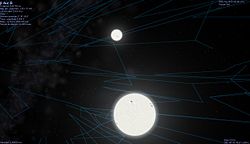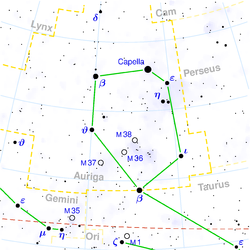- Beta Aurigae
-
Beta Aurigae Observation data
Epoch J2000.0 Equinox J2000.0Constellation Auriga Right ascension 05h 59m 31.7s Declination +44° 56′ 51″ Apparent magnitude (V) +1.896 Characteristics Spectral type A2IV / A2IV / MV U−B color index +0.05 B−V color index +0.03 R−I color index -0.01 Variable type Algol variable Astrometry Radial velocity (Rv) −18.2 km/s Proper motion (μ) RA: −56.41 mas/yr
Dec.: −0.88 mas/yrParallax (π) 39.72 ± 0.78 mas Distance 82.1 ly
(25.2 pc)Absolute magnitude (MV) 0.55/0.76[1] Details Mass 2.38/2.31[2] M☉ Radius 2.77/2.63[2] R☉ Surface gravity (log g) 3.93/3.98[1] Luminosity 48/48[3] L☉ Temperature 9,350/9,200[2] K Metallicity 100% Rotation 33/34[2] km/s Age 5.7 × 108[2] years Other designations Menkalinan, 34 Aurigae, ADS 4556, BD +44°1328, CCDM 05596+4457, FK5 227, GC 7543, HD 40183, HIP 28360, HR 2088, NN 3375, SAO 40750.Database references SIMBAD data Database references SIMBAD data Data sources: Hipparcos Catalogue,
CCDM (2002),
Bright Star Catalogue (5th rev. ed.)Beta Aurigae (β Aur, β Aurigae), traditionally named Menkalinan, is a white subgiant ternary star system approximately 85 light-years away in the constellation Auriga.
Contents
Nomenclature
The name Menkalinan is shortened from the Arabic منكب ذي العنان mankib ðī-l-‘inān "shoulder of the rein-holder". It is known as 五車三 (the Third Star of the Five Chariots) in feudal Chinese astronomy.
System components
Beta Aurigae is actually a ternary (triple) star system, although the light that the star system releases forges the appearance of a single star in the night sky. The two brightest components, Beta Aurigae A and B, are both white subgiants falling under the A-type stellar classification; Beta Aurigae B is about the same mass and radius as A. A-type entities are hot stars that release a blue-white light; these two stars burn brighter and with more heat than the Sun, which is a G2-type subgiant star.
The third star, Beta Aurigae C, is a red dwarf star that is invisible to the naked eye. The C component is about 330 AU from the AB pair.
Variability
Beta Aurigae's primary and secondary stars constitute an eclipsing spectroscopic binary; the combined apparent magnitude varies over a period of 3.96004 days between +1.85 and +1.93, as every 47.5 hours one of the stars partially eclipses the other from Earth's perspective.
Beta Aurigae is believed to be a stream star member of the Ursa Major Moving Group.
See also
References
- ^ a b Torres, G.; Andersen, J.; Giménez, A. (February 2010). "Accurate masses and radii of normal stars: modern results and applications". The Astronomy and Astrophysics Review 18 (1-2): 67–126. Bibcode 2010A&ARv..18...67T. doi:10.1007/s00159-009-0025-1.
- ^ a b c d e Nordstrom, B.; Johansen, K. T.. "Radii and masses for beta Aurigae". Astronomy and Astrophysics 291 (3): 777–785. Bibcode 1994A&A...291..777N.
- ^ Kaler, James B.. "MENKALINAN (Beta Aurigae)". University of Illinois. http://stars.astro.illinois.edu/sow/menkalinan.html. Retrieved 2010-01-23.
External links
Bayer Flamsteed 2 • 3 (ι, Hassaleh) • 4 (ω) • 5 • 6 • 7 (ε, Almaaz) • 8 (ζ, Sadatoni) • 9 • 10 (η) • 11 (μ) • 12 • 13 (α, Capella) • 14 • 15 (λ) • 16 • 17 • 18 • 19 • 20 (ρ) • 21 (σ) • 22 • 24 (φ) • 25 (χ) • 26 • 27 (ο) • 28 • 29 (τ) • 30 (ξ) • 31 (υ) • 32 (ν) • 33 (δ) • 34 (β, Menkalinan) • 35 (π) • 36 • 37 (θ) • 38 • 39 • 40 • 41 • 42 • 43 • 44 (κ) • 45 • 46 (ψ¹) • 47 • 48 • 49 • 50 (ψ²) • 51 • 52 (ψ³) • 53 • 54 • 55 (ψ4) • 56 (ψ⁵) • 57 (ψ6) • 58 (ψ7) • 59 • 60 • 61 (ψ8) • 62 • 63 • 64 • 65 • 66Nearby QY • UGPS J0521+3640List Categories:- Algol variables
- Auriga constellation
- Bayer objects
- Flamsteed objects
- Henry Draper Catalogue objects
- HIP objects
- M-type main sequence stars
- Spectroscopic binaries
- A-type subgiants
- Triple star systems
- Stars with proper names
Wikimedia Foundation. 2010.


